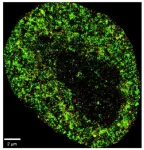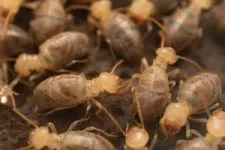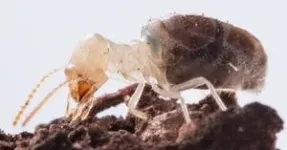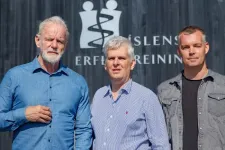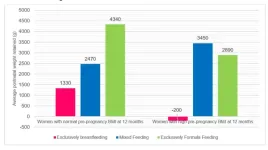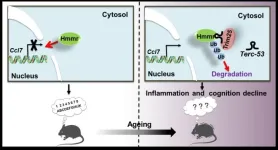(Press-News.org) Researchers at the Centre for Genomic Regulation (CRG), the University of the Basque Country (UPV/EHU), Donostia International Physics Center (DIPC) and the Fundación Biofisica Bizkaia (FBB, located in Biofisika Institute) have developed an artificial intelligence which can differentiate cancer cells from normal cells, as well as detect the very early stages of viral infection inside cells. The findings, published today in a study in the journal Nature Machine Intelligence, pave the way for improved diagnostic techniques and new monitoring strategies for disease.
The tool, AINU (AI of the NUcleus), scans high-resolution images of cells. The images are obtained with a special microscopy technique called STORM, which creates a picture that captures many finer details than what regular microscopes can see. The high-definition snapshots reveal structures at nanoscale resolution.
A nanometre (nm) is one-billionth of a metre, and a strand of human hair is about 100,000nm wide. The AI can detect rearrangements inside cells as small as 20nm, or 5,000 times smaller than the width of a human hair. These alterations are too small and subtle for human observers to find with traditional methods alone.
“The resolution of these images is powerful enough for our AI to recognise specific patterns and differences with remarkable accuracy, including changes in how DNA is arranged inside cells, helping spot alterations very soon after they occur. We think that, one day, this type of information can buy doctors valuable time to monitor disease, personalise treatments and improve patient outcomes,” says ICREA Research Professor Pia Cosma, co-corresponding author of the study and researcher at the Centre for Genomic Regulation in Barcelona.
‘Facial recognition’ at the molecular level
AINU is a convolutional neural network, a type of AI specifically designed to analyse visual data like images. Examples of convolutional neural networks include AI tools which enables users to unlock smartphones with their face, or others used by self-driving cars to understand and navigate environments by recognising objects on the road.
In medicine, convolutional neural networks are used to analyse medical images like mammograms or CT scans and identify signs of cancer that might be missed by the human eye. They can also help doctors detect abnormalities in MRI scans or X-ray images, helping make a faster and more accurate diagnosis.
AINU detects and analyses tiny structures inside cells at the molecular level. The researchers trained the model by feeding it with nanoscale-resolution images of the nucleus of many different types of cells in different states. The model learned to recognize specific patterns in cells by analysing how nuclear components are distributed and arranged in three-dimensional space.
For example, cancer cells have distinct changes in their nuclear structure compared to normal cells, such as alterations to how their DNA is organised or the distribution of enzymes within the nucleus. After training, AINU could analyse new images of cell nuclei and classify them as cancerous or normal based on these features alone.
The nanoscale resolution of the images enabled the AI detect changes in a cell's nucleus as soon as one hour after it was infected by the herpes simplex virus type-1. The model could detect the presence of the virus by finding slight differences in how tightly DNA is packed, which happens when a virus starts to alter the structure of the cell's nucleus.
“Our method can detect cells that have been infected by a virus very soon after the infection starts. Normally, it takes time for doctors to spot an infection because they rely on visible symptoms or larger changes in the body. But with AINU, we can see tiny changes in the cell's nucleus right away,” says Ignacio Arganda-Carreras, co-corresponding author of the study and Ikerbasque Research Associate at UPV/EHU and affiliated with the FBB-Biofisika Institute and the DIPC in San Sebastián/Donostia.
“Researchers can use this technology to see how viruses affect cells almost immediately after they enter the body, which could help in developing better treatments and vaccines. hospitals and clinics, AINU could be used to quickly diagnose infections from a simple blood or tissue sample, making the process faster and more accurate,” adds Limei Zhong, co-first author of the study and researcher at the Guangdong Provincial People's Hospital (GDPH) in Guangzhou, China.
Laying the groundwork for clinical readiness
The researchers have to overcome important limitations before the technology is ready to be tested or deployed in a clinical setting. For example, STORM images can only be taken with specialized equipment normally only found in biomedical research labs. Setting up and maintaining the imaging systems required by the AI is a significant investment in both equipment and technical expertise.
Another constraint is that STORM imaging typically analyses only a few cells at a time. For diagnostic purposes, especially in clinical settings where speed and efficiency are crucial, doctors would need to capture many more numbers of cells in a single image to be able to detect or monitor a disease.
“There are many rapid advances in the field of STORM imaging which mean that microscopes may soon be available in smaller or less specialized labs, and eventually, even in the clinic. The limitations of accessibility and throughput are more tractable problems than we previously thought and we hope to carry out preclinical experiments soon,” says Dr. Cosma.
Though clinical benefits might be years away, AINU is expected to accelerate scientific research in the short term. The researchers found the technology could identify stem cells with very high precision. Stem cells can develop into any type of cell in the body, an ability known as pluripotency. Pluripotent cells are studied for their potential in helping repair or replace damaged tissues.
AINU can make the process of detecting pluripotent cells quicker and more accurate, helping make stem cell therapies safer and more effective. “Current methods to detect high-quality stem cells rely on animal testing. However, all our AI model needs to work is a sample that is stained with specific markers that highlight key nuclear features. As well as being easier and faster, it can accelerate stem cell research while contributing to the shift in reducing animal use in science,” says Davide Carnevali, first author of the research and researcher at the CRG.
END
London, United Kingdom – 27 August 2024: Clinical follow-up using virtual voice technology helped identify complications after transcatheter aortic valve implantation (TAVI) with a high degree of patient satisfaction, according to research presented at ESC Congress 2024.1
Explaining the rationale for the development of the virtual voice assistant for TAVI patients, study author Dr. Marta Herrero Brocal from the Dr. Balmis General University Hospital of Alicante, Spain said: “Aortic valve stenosis is common, especially in the ageing population.2 It can be treated with surgery ...
London, United Kingdom – 27 August 2024: Research from two studies in different European cities1,2 highlights that urban noise pollution has a significant negative impact on heart health, according to data presented at ESC Congress 2024.
“The DECIBEL-MI study shows that young patients aged 50 years or less who had a myocardial infarction (MI) had been exposed to higher levels of noise than the general population. The study demonstrates that urban noise could significantly increase the risk of early-onset MI in young people with low traditional risk factors. Including ...
Scientists at deCODE genetics and collaborators, have identified a sequence variant in the CCDC201 gene that when inherited from both parents homozygous causes menopause on average nine years earlier.
deCODE genetics, a subsidiary of Amgen, and collaborators from Iceland, Denmark, the UK, and Norway published a study in Nature Genetics today revealing a rare genotype with a significant impact on women's health.
Age at menopause significantly affects fertility and disease risk. This research focused on ...
London, United Kingdom – 27 Aug 2024: New research presented at the ESC Congress 2024 in London, UK (30 August – 2 September) shows that women in the menopause transition period show changes in their blood cholesterol profiles which could have an adverse impact on their cardiovascular health.
“There is an increase in ‘bad’ low-density type lipoprotein (LDL) particles and a decrease in ‘good’ high-density lipoprotein particles (HDL) that takes place during and after the menopause transition,” says study author Dr Stephanie Moreno, University of Texas Southwestern Medical Center, Dallas, TX, USA. “Taken ...
Millions of women who work in the fisheries industry are being left behind as technologies develop to counter the effects of climate change and economic pressures.
New research led by the University of East Anglia (UEA) looks specifically at post-harvest fisheries and aquaculture, where women constitute 50 per cent of the total workforce. Despite their significant contributions women often remain invisible, are unpaid or underpaid, their work seen as an extension of household work.
The findings, ‘A systematic review of the impact of post-harvest aquatic food ...
The James Webb Space Telescope has spotted six likely rogue worlds—objects with planetlike masses but untethered from any star’s gravity—including the lightest ever identified with a dusty disk around it.
The elusive objects offer new evidence that the same cosmic processes that give birth to stars may also play a common role in making objects only slightly bigger than Jupiter.
“We are probing the very limits of the star forming process,” said lead author Adam Langeveld, an astrophysicist at Johns Hopkins University. “If you have an object that looks like a young Jupiter, is it possible that ...
A two-faced star, a star as massive as the Sun but as compact as the Moon, and star ‘corpses’ that engulf entire planets and disrupt planetary orbits. Ilaria Caiazzo, an astrophysicist who has made stunning discoveries, joins the Institute of Science and Technology Austria (ISTA) as a new assistant professor. Her path led her from philosophy to studying stellar evolution and death while managing her broad interests including movie production.
Ilaria Caiazzo has always had a broad spectrum of interests. Her path to astrophysics started in philosophy and ...
Dungeons and Dragons is a hugely popular roleplaying game enjoyed by millions of people all over the world, both in person and online, every day.
However, new research has found it could be particularly beneficial for people with autism, giving them a safe space to engage in social interactions away from some of the challenges they face in their daily lives.
The study, published in the journal Autism, was led by researchers from the University of Plymouth’s School of Psychology along with colleagues at Edge ...
27 August 2024, Singapore – A KK Women’s and Children’s Hospital (KKH) study[1] on breastfeeding practices revealed that among the women who exclusively breastfed, those with high body mass index[2] (BMI) before pregnancy lost more weight than women with a healthy BMI pre-pregnancy.
Women with high BMI who exclusively breastfed, in addition to losing their pregnancy weight, lost an extra 200 grammes on average, 12 months after childbirth. Women with normal BMI who exclusively breastfed lost weight ...
The authors investigate the physiological functions of Terc-53 by creating transgenic mice that overexpress this noncoding RNA. They observe that Terc-53 overexpression affects normal aging in mammals, contributing to cognitive decline and shortened lifespan. Mechanistically, they find that Terc-53 binds to and promotes the degradation of Hmmr, leading to enhanced inflammation in tissues and accelerated aging. They also note that Hmmr levels decrease with age in certain brain regions, similar to Terc-53's pattern, and that restoring Hmmr levels can improve cognitive abilities ...
